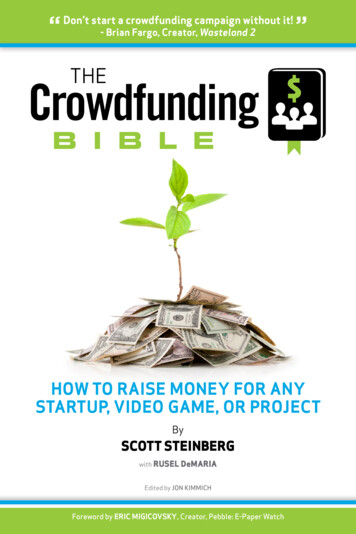
Transcription
a crowdfunding campaign without it!“ Don’t start”- Brian Fargo, Creator, Wasteland 2THECrowdfundingb i b l eHOW TO RAISE MONEY FOR ANYSTARTUP, VIDEO GAME, OR PROJECTBySCOTT STEINBERGwith RUSEL DeMARIAEdited by JON KIMMICHForeword by Eric Migicovsky, Creator, Pebble: E-Paper Watch
THECrowdfundingb i b l eW H AT T H E Y ’ R E S AY I N G“Every entrepreneur thinking about jumping into the wildworld of crowdfunding needs to read this.”– J. Jennings Moss, Editor, Portfolio.com“A must-read for anyone who wants to use the power ofpeople, the Internet and social media to get projects offthe ground.”– Rich DeMuro, Tech Reporter, KTLA-TV“Don’t start a crowdfunding campaign without it! ”– Brian Fargo, Creator, Wasteland 2“A comprehensive look at the benefits and, moreimportantly, the potential pitfalls of crowdfunding thatany developer ought to read before getting started.”- James Brightman, US Editor, GamesIndustry InternationalTHE crowdfunding bible
A DDITIO N A L R E SO U RCE S:STRATEGIC CONSULTING PRODUCT TESTING MARKET RESEARCH EXPERT WITNESSESFREE BOOK FOR DOWNLOAD:SMALL BUSINESS TIPS, TECH TRENDS,AND ONLINE MARKETING bal.comAs Seen On:social media expertserieswww.ASocialMediaExpert.comSOCIAL MEDIA CONSULTANTS:FACEBOOK, TWITTER, GOOGLE (PLUS), YOUTUBE AND MOREwww.ASocialMediaExpert.comWORK, LIFE AND FAMILY TIPSPRODUCT NEWS, REVIEWS AND TRENDSwww.TechSavvyMag.comTHE crowdfunding bibleTHE crowdfunding bible
THE CROWDFUNDING BIBLE:Published By:HOW TO RAISE MONEYFOR ANY STARTUP, VIDEOGAME, OR PROJECTSCOTT STEINBERGWRITERS WANTEDWithfor technology and business booksRusel DeMariawww.BooksAboutTechnology.comEdited byJon KimmichTHE crowdfunding bibleTHE crowdfunding bible
THE CROWDFUNDING BIBLE:HOW TO RAISE MONEY FOR ANY STARTUP,VIDEO GAME, OR PROJECTAll Rights Reserved 2012 by Overload Entertainment, LLCD E D I C AT I O NTo Z, for whom endless possibilities await, and every aspiring entrepreneur– with barriers to market entry rapidly crumbling, there’s no better time toact than the present. As dozens of enterprising new creators and startups areproving, General Electric’s not the only with the power to bring good things tolife: Get out there and start something today.No part of this book may be reproduced or transmitted in any form or by any means – graphic,electronic or mechanical – including photocopying, recording, taping or by any information storageretrieval system, without the written permission of the publisher.LIMIT OF LIABILITY/DISCLAIMER OF WARRANTY: THE PUBLISHER AND THE AUTHOR MAKE NOWARRANTIES OR REPRESENATIONS REGARDING THE ACCURACY OR COMPLETENESS OF THE CONTENTS OFTHIS WORK AND SPECIFICALLY DISCLAIM ALL WARRANTIES, INCLUDING WITHOUT LIMITATION WARRANTIESOF FITNESS FOR A PARTICULAR PURPOSE. THE ADVICE AND STRATEGIES CONTAINED HEREIN MAY NOT BESUITABLE FOR EVERY SITUATION. THIS WORK IS SOLD WITH THE UNDERSTANDING THAT THE PUBLISHERAND AUTHOR ARE NOT ENGAGED IN RENDERING PROFESSIONAL SERVICES SUCH AS LEGAL, ACCOUNTINGOR OTHER. IF PROFESSIONAL ASSISTANCE IS REQUIRED, A COMPETENT PROFESSIONAL PERSON SHOULDBE CONSULTED. NEITHER THE PUBLISHER NOR THE AUTHOR SHALL BE LIABLE FOR DAMAGES ARISINGHEREFROM. THE FACT THAT AN ORGANIZATION OR WEBSITE IS REFERRED TO IN THIS WORK AS A CITATIONAND/OR A POTENTIAL SOURCE OF FURTHER INFORMATION DOES NOT MEAN THAT THE AUTHOR ORTHE PUBLISHER ENDORSES THE INFORMATION THAT THE ORGANIZATION OR WEBSITE MAY PROVIDEOR RECOMMENDATIONS IT MAY MAKE. FURTHER, INTERNET WEBSITES LISTED IN THIS WORK MAY HAVECHANGED OR DISAPPEARED BETWEEN THE TIME THIS WORK WAS WRITTEN AND WHEN IT IS READ. NOWARRANTY MAY BE CREATED OR EXTENDED BY SALES OR PROMOTIONAL MATERIALS.To order copies or to request permission to reprint, contact the publisher at:Published by nessexpert.comTHE crowdfunding bibleTHE crowdfunding bible
F O R E W O R DThere’s no denying that crowdfunding represents a fundamental change in the way thattechnologies, products and entrepreneurs are evaluated. Until recently, a relatively smallnumber of very wealthy individuals held the purse strings of the creative world. Venturecapitalists and angels were the gatekeepers to Silicon Valley, and they were quite selective.Innovation and creativity yearned for realization, and countless opportunities and ideas werelost forever – but out of the need for innovation came innovation itself. Just as the PC broughtcomputers to the masses, so too does crowdfunding put funding for innovation in the hands of,well the crowd.Crowdfunding remains a financial instrument in transition. It’s impossible to say what it willlook like in five years, but it is equally difficult to envision a future without crowdfunding. Afterpounding the pavement and meeting various investors, I thought that I would not be able tocarry through with my plan for Pebble. Just a few years ago it would have been dead withoutthe support of investors. But thanks to Kickstarter and crowdfunding, and the tens of thousandsof people who helped back us, my innovation is coming to life, and I hope the world will be abetter place as a result.My journey is exactly why crowdfunding is so important: Innovation cannot be lost to a VC’sinbox. Innovation is too important for one man, or one firm, to pass judgment on. My innovationis not a world-changer, and yet fifty thousand people gave me millions of yeses when I couldn’teven get a venture capital firm to give me a single no. Innovation serves and benefits themasses, and deserves to be judged by them. Crowdfunding may not yet be totally there yet, butI for one am excited to see what its future holds.– Eric MigicovskyTHE crowdfunding bibleTHE crowdfunding bible1
An Introduction to CrowdfundingWant to start your own business or have a great idea for tomorrow’s next million-dollarinvention? Congratulations – crowdfunding gives you the power to bring entire businesses and better widgets to life overnight. But what is crowdfunding exactly, howdoes it compare to crowdsourcing, and (more importantly) how can you use it to provide venture capital for any project or startup? In this book you’ll find some handy hints, tips and how-toguides, as well as commentary from leading experts and crowdfunding veterans, to harnessingthe ultimate in people power.Following is a detailed overview of guiding business principles and case studies that you, asa modern entrepreneur, can utilize to create your own successful crowdfunding campaign. Notethat while many examples here may come from the video games and interactive entertainmentindustry (among the fields that have benefited most financially from this practice), they’re alsoapplicable to many other consumer-facing sectors, including consumer electronics, periodicals,books, film, television, fashion and even special events and community projects. Worth keeping in mind too: As we go to press, close to 10 million in project funding has been raised inthe last three months within the games industry alone, with success stories including DoubleFine ( 3.3M), Wasteland 2 ( 2.9M ), Shadowrun Returns ( 1.4M ) and more. Given the volume ofpublic attention and dollars such campaigns have attracted, it’s fully anticipated that this growthcurve will continue in virtually every vertical – at least for the foreseeable future.The good news for aspiring inventors and startups: With the right project and assets toconvey your vision to potential backers, and a detailed understanding of how to engage withtoday’s audiences, anyone can make their dreams a reality. Better yet, you too can participate inthis exciting new means of funding, and launch nearly any promising new project or business.Ready to dive in headfirst and begin raising attention and capital for your latest and greatestideas? Let’s begin by taking a deeper look at what crowdfunding means, and how exactly thefield works.What is Crowdfunding?Simply put, crowdfunding is the process of asking the general public for donations thatprovide startup capital for new ventures. Using the technique, entrepreneurs and small business owners can bypass venture capitalists and angel investors entirely and instead pitch ideasstraight to everyday Internet users, who provide financial backing. (At the same time, you willalso gain early validation of project concepts and the projected scope of target markets.) Usingservices like Kickstarter and IndieGogo, creators essentially build web pages that host information, photos and promotional videos on products, projects or services they’re looking to getfunded. Viewers are then offered special rewards in exchange for pledges that support theirefforts. Rather than equity or a share of profits though, benefits often take the form of exclu-2THE crowdfunding biblesive merchandise, advance access to new releases, or more personal incentives. In the case ofa movie, for example, donating 20 might get you a copy of the DVD, 50 a signed poster, and 500 an executive producer credit. For a larger donation (say, 2500), you might get a personalhandwritten thank you note from the director, invite to an exclusive launch party, or even a bitpart in the movie itself.An offshoot of crowdsourcing – a business practice that involves asking user communities tosubmit ideas or contributions, e.g. possible designs for your firm’s new logo – crowdfunding hasrecently grown in popularity. Many small projects have gotten the support they’ve needed toget off the ground, while a few very high-profile projects, such as Double Fine’s new adventuregame (which netted its first million in just 24 hours and turned the heads of many hopeful gamedevelopers) are quickly kicking down the doors for larger, full-scale ventures.Advantages of the Crowdfunding ModelCrowdfunding doesn’t just help you finance your projects – it also lets you gauge publicinterest before launching new products or inadvertently spending millions on goods destinedto collect dust in a warehouse. Some even say it’s the best thing to happen to business sinceApple’s App Store. More important to note though is that you don’t have to be a large, successful business to tap into its power – and that nearly any venture from art exhibitions to charityfundraisers can benefit. Whether looking to boost interest in a new neighborhood record storeor skate park, or your grandkids’ school fair, even everyday individuals can enjoy the heightenedsupport and publicity such campaigns bring.Furthermore, this strategy not only allows you to gauge the scope of general consumer in-THE crowdfunding bible3
terest in, and test the validity of, new concepts. It also gives you a direct conduit to shoppers, including those who are willing early financial supporters, and consequently the likeliest to spendmore on updates and future releases. (A value proposition that becomes even more attractive ifyour product incorporates opportunities for the post-release purchase of additional content, e.g.via add-ons, expansions and microtransactions ) As an added benefit, crowdfunding additionally allows you to start forging early and strong relationships with committed customers, whowill ultimately become your product’s top advocates upon release.From an entrepreneur’s standpoint, it’s hard to argue with the results. Under typical scenarios, business owners make educated guesses about products that people will be interestedin, and how much they’ll be willing to buy. Using crowdfunding, they can instead test ideas atlittle up-front cost and then spend accordingly. What’s more, crowdfunding provides a betterway to generate interest in projects and pre-orders up-front. Not only are customers more emotionally invested in the development process, they’re also more emotionally invested in the endresult. Advance purchases also provide working capital to fuel production, and rewards offeredin exchange for fans’ support provide a positive way to give back to deserving contributors. Bestof all, crowdfunding lets you launch big ideas with next to no advance costs, and launch themright from your kitchen table. Even better, you can monitor and manage the process from yourhome computer, laptop or even your iPad.Another significant advantage of crowdfunding is that you don’t give away any ownershipor equity stake in the venture. Traditional sources of investment typically require that you giveup a portion of a company or project in exchange for their support. Moreover, investors frequently expect a quick return on investment (ROI), often at odds with entrepreneurs’ focus onlong-term value creation – and can even influence your project in ways you hadn’t anticipated,and sometimes don’t welcome. In contrast to the crowdfunding model, which affords backersno formal creative or commercial power over your project, traditional investment models, andinvestors, can often hold your feet to the fire at any time.Here are some pros and cons to crowdfunding vs. traditional investment vehicles:Crowdfunding ProsYou control everything, including costs, timing, delivery, creative vision and execution, marketing and customer interactions.You keep your equity: Projects and businesses remain 100% yours.You get to test and prove out the popularity of your model, using as little as a prototype orpreproduction materials.You may also be able to test elements of your product’s marketing approach and how well4THE crowdfunding bibleindividual promotional aspects or overarching campaigns resonate with target consumers.You can sometimes make much more than you ever intended, or asked for. Under traditionalinvestment scenarios, entrepreneurs must typically supply detailed business plans and budgets thatjustify their funding requests, negotiate the transfer of ownership stakes, and haggle over the actualvalue of their enterprise. Some companies and projects may require multiple rounds of funding,each of which demands additional negotiations and compromises, with the added risk (and stress)of having to prove the validity and worth of your project at each step. With crowdfunding, if yourproduct resonates strongly with your audience, you may well exceed your funding target. Successful campaigns have raised as much as 4x or even 8x their original funding goals.Lucky or well-run crowdfunding projects can begin sourcing contributions with as little as apolished pitch – and may exceed funding goals many times over, without having to justify eachadditional dollar contributed. (Caveat: Such scenarios are not necessarily the norm, but happen oftenenough to take into consideration when debating which investment channels to use.) Unlike traditional investment ventures, which adhere closely to predefined game plans and budgets, someprojects may even grow in feature set, scope and/or ambition with the extra money generated.One point to be aware of, however: As the market for pre-retailing your product develops, thebar will be raised as to what customers expect in terms of “sales materials” for crowdfundingefforts. You should always benchmark your project materials against those of similar campaignsin your chosen field or genre.If at first you don’t succeed Should you fail to meet your goal, you lose nothing (other thantime and the occasional dent to your public image) and can try again, with an improved planand presentation. Generally, if you fail to impress investors, you can consider yourself very lucky ifthey’ll give you a second chance. Bear in mind when considering rebooting campaigns, though:If you are targeting the same customers or audience, they may well remember your earlier campaign, and its failure may have negative consequences.You can pre-sell your product or service, and depending on the costs associated with it, youmay be able to get more than the actual retail value from backers who believe in your project.You’re also mitigating risk and earning capital that can be directly applied towards productionand marketing costs at the same time.An unexpected benefit of crowdfunding campaigns is that you will often receive very usefuladvice – and even tangible offers of assistance – from backers, who, after all, want you to succeed and will do everything they can to help you get there.Your backers become your built-in marketing team and crew of brand evangelists, helping topromote your project to all their friends and contacts.THE crowdfunding bible5
Crowdfunding ConsIt’s stressful. Talk to almost anyone who has run a crowdfunding project, and they’ll tell youthat running a campaign isn’t easy, and that it’s usually filled with unexpected ups and downs– even when successful. On the emotional roller coaster scale, think Space Mountain not thekiddie rides.Plotting successful crowdfunding ventures demands a different kind of preparation than traditional product pitches. You’re reaching out to end consumers, not professional investors – acompletely different and far more diverse audience. This may require knowledge of consumermarketing, social networks and social marketing techniques in order to converse with these customers, as well as some familiarity with customer acquisition and conversion as well.It puts you and your ideas out directly in front of the public – and, potentially, the line of fire.Crowdfunding isn’t for the faint of heart or the terminally bashful. There’s also no opportunity tooperate in stealth mode, meaning that competitors may be able to capitalize on public knowledge of your company or product.Success requires investing tireless effort into ongoing social marketing campaigns, and constant self-promotion, throughout the entire duration of the fundraising campaign. If you’re shy,guarded or soft-spoken by nature, you’ll have to get over these tendencies to run a successfulcrowdfunding campaign – or find someone else to serve as a project spokesperson.It requires that you be very creative about drumming up interest in your project, and it meansyou will be constantly looking for new ways to publicize, promote and otherwise call attentionto your campaigns and surrounding efforts.It doesn’t always work. That’s not to say that you should be discouraged about the chancesof successfully crowdfunding a project, but you do have to be realistic, and prepare yourself forpotential failure. This often means having to have a Plan B – and C, D, etc.Crowdfunding requires that your project – whatever its theme, scope or contents – be something that interests a sufficient number of people strongly enough to motivate them to partwith hard-earned cash. Part of the process of evaluating whether to undertake a crowdfundingeffort is to take a careful, critical look at your project and assess the size of the potential audienceto whom it will appeal, as well as the perceived value it will bring them. When you are executingthe campaign, you’ll have to target this market specifically, and you’ll need to strategize how toengage them where they consume media, news, opinions and insights on a regular, runningbasis – no small task.6THE crowdfunding bibleWith crowdfunding, you assume responsibility for dealing with an often larger and potentiallymore diverse set of backers than under traditional investment scenarios – all of whom may havediffering expectations and demands. Likewise, few examples exist thus far that illustrate theramifications of crowdfunded products that have not been released, or where a product waspitched and funded, but a wildly different product was ultimately released. Consider the potential impact to your projects, livelihood and business.Finally, no matter how interesting your project is, know that you will be competing againstother projects – many of which may be vying for the same target audience, share of voice andpool of disposable income. And, as crowdfunding grows in popularity and notoriety, the commercial landscape will become even more competitive.THE REALITY OF CROWDFUNDING“If you think crowdfunding is easy, guess again: It’s definitely not. It’s actuallypretty scary, because you have to be prepared to put yourself out there on display [for the public]. It’s the Internet and you have to expect mixed feedback.”Jane Jensen, Pinkerton Road: A Year of AdventureKicking it ForwardCompetition for crowdfunding dollars is already high, and destined to become even morecompetitive as time passes. Sometimes it pays to give back: That’s why Brian Fargo,whose successful Wasteland 2 campaign earned nearly 3 million, recommends embracing the Kick It Forward concept – a pledge by those who’ve successfully crowdfunded venturesto donate 5% of the profits (after shipping and expenses) from their finished projects to fundother crowdfunding projects. In his own words:“Any developer that puts the “Kicking it Forward” badge on their Kickstarter project pageis agreeing that they will put 5% of their finished product profits back into other Kickstarterprojects. To be abundantly clear, this is only money that the developer earns as profit AFTERthe project ships and AFTER they have paid their expenses. This is NOT a suggestion to investmoney they received from people who invested into their project via Kickstarter.”Note that while the concept of Kicking It Forward started on Kickstarter, it may quicklyspread to other crowdfunding sites under a variety of different names and forms. This ingeniousidea helps assure that more projects will get funded in the future, allowing the backers of projects that support Kicking It Forward to offer continued support to the crowdfunding move-THE crowdfunding bible7
ment. We recommend considering it for any campaign. Besides being a kind gesture that letsyou also set a good example, positively give back to the community and help others meet theirfunding goals, the goodwill it generates can be priceless. Creators can use all the support theycan get – and you yourself may even need to call in a favor yourself from them someday, drawing upon their connections, customers and/or business savvy.Traditional Investment ProsA relationship that’s supposed to be strictly business: Each party clearly spells out and understands what’s being offered in exchange for the other’s support – duties and obligations, at leastin theory, begin and end at what’s on the signed contract.The scope of projects, as well as their general feature set and budgetary demands, are typically outlined at the outset of the relationship, and – for better or worse – cannot often deviate,because of the fixed nature of schedules, plans and funding. This allows for greater focus.You can get right down to work. Once you have secured funding, you are ready to begin diving into the business of running your business on a day to day basis.You get validation. Traditional investors often have extensive experience with the kinds ofprojects they fund, and don’t fund projects they don’t see a need for or personally believe in. Soif you’ve pitched an investor successfully, you have already convinced one of the world’s toughest and most demanding audiences that your ideas have merit.You often get support and expert advice. Wise investors will many times step in and offer youcounsel or request (and unfortunately sometimes demand) a course correction if they see yourbusiness or leadership team floundering or headed in what they believe to be the wrong direction. Often, this advice is well worth considering. Likewise, it’s important to remember that connections can be equally important as cash itself: Frequently, investors will open doors, make introductions and provide entrees to new clients or arenas worth several times their weight in gold.When things go well, and your project is moving forward, investors will actively do what theycan to speed ventures along and help you succeed – assistance that shouldn’t be discounted,given the considerable financial and professional clout they can often bring to bear.Traditional Investment Consto secure financial backing. Other scenarios may see you having to forego a share of profits, paya licensing fee on every transaction, or be forced to meet stringent project milestones or deliverables at the risk of losing funding, the IP being created or even the entire business itself.If you didn’t raise enough to fund your project fully from initial investors, miscalculatedbudgetary needs or scheduling slips and development difficulties raise production costs, youmay find yourself in an untenable position – and may end up scrambling to make payroll and/or forced to give away more equity to secure additional funds from further sources. Note thatcrowdfunding can be a means of closing funding gaps without having to take on additionaldebt or incur another round of equity financing, though – should they be necessary – backersmay be every bit as skeptical (if not more so) of secondary funding rounds as traditional investors.Investors operate on a timeline. Many look for a quick turnaround on their investment. Whilethe actual amount of time varies by project, deal and individual preference, as a general rule,it pays to realize: They’re not offering the equivalent of a 30-year home mortgage. In general,financial backers expect to make a high return on investment on funds placed into your project/company in a short amount of time. This may or may not conform directly to your comfort zone,and may give investors’ undue leverage over the venture – because they hold the money, theyoften hold the majority of the cards.As pointed out in the Pros section prior, advice and introductions provided by investors canoften be very valuable. But it can sometimes be just as devastating as well, because outsideparties’ vision and goals for any venture don’t necessarily align with your own. Investors ultimately want projects to go in a direction that realizes the maximum amount of profit for themin the least amount of time. Some may not afford you the time, support or freedom of creativevision you need to develop your project or company to its full potential – at least, insofar as youdefine success.The Benefits of Crowdfunding“Crowdfunding was the best way that Wasteland 2 could have happened. Anyother funding method would have had strings and people who had ideas attached to it. I believe that there’s a direct correlation between developers withindependence and quality. To be sure, the people at companies like Blizzard,Valve and other top software makers are very talented, but they also get to determine when projects are done. They do what they think is right.”-Brian Fargo, Wasteland 2Under most scenarios, receiving investment from outside sources requires giving away equityin your intellectual property (IP) or project – and sometimes in your whole company – in order8THE crowdfunding bibleTHE crowdfunding bible9
Who Should Consider Crowdfunding?IMPROVING YOUR CHANCES OF SUCCESS“To improve chances of success, you want to build a project or product whereyou think you’re filling a hole. Part of the trick is showing people things thatthey either a) haven’t seen in a long time or b) things they haven’t seen before.”-Brian Fargo, Wasteland 2There are several factors to consider if you are thinking about using a crowdfunding modelto finance a business, product, project, service or event.1. How good is your idea – really? Are you certain that people will be interested in it?2. Why is your product, service or venture destined to sell – what value does it offer the customer?3. What differentiates your project from existing competitors, or alternatives that have comebefore? Are you utilizing an existing brand, IP or personality that has a pre-existing base offans or consumers? (Using an existing, if perhaps older, brand or IP which consumers havefond memories of can be a very effective strategy.)4. Can you express your idea simply and at the same time get people excited about it? If not,it may be that the idea isn’t all that compelling, or that you may not be the right person tocommunicate or present it.5. Do you have something tangible to show when presenting your venture – some visual aspect of your project that can help other people visualize it?6. How well do you know and understand your target audience?7. Do you have confidence in your ability to reach out and connect with potential backers?Have you planned which vehicles you will use to reach out and connect with them?8. Have you calculated just how much money you need – truly need – to get your ideas off theground?9. Have you factored in all financial variables, including the costs of reward fulfillment, payments to the crowdfunding service, and taxes?10. Have you been sensible enough to build a budget that allows for breathing room in certainareas, and factors in conservative projections?11. Are you positive that you can fulfill all your promises, including completing the project in theallotted timeframe, and delivering on all features and content covered in your pitch? Haveyou considered the impact on your product’s brand identity, or your own personal brand,should your campaign not succeed?12. Do you have some great rewards in mind to give backers and fans incentive to donate?10THE crowdfunding bibleHave you mapped out your reward tiers? How will you offer these rewards, and what dollaramount will you attach to them?13. Can you offer meaningful rewards at a variety of investment levels to attract all potentialpatrons?14. What specific or unique rewards will you use to get people talking? Can you create any singular ones that can be utilized in social media campaigns or for press outreach?15. Do you understand all the personal and professional demands that the process of running acrowdfunding campaign demands from creators? Are you prepared to put 110% effort intomaking your crowdfunding project a success?16. Do you have at least some marketing, public relations and social media connections andsavvy?17. What promotional campaign activities do you plan to pursue leading up to and duringlaunch? How will you keep the buzz going after your
4 THE CROWDFUNDING BIBLE THE CROWDFUNDING BIBLE 5 terest in, and test the validity of, new concepts. It also gives you a direct conduit to shoppers, in - cluding those who are willing early financial supporters, and consequently the likeliest to spend more on updates and future releases. (A value proposition that becomes even more attractive if










